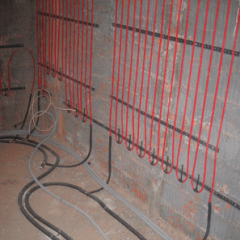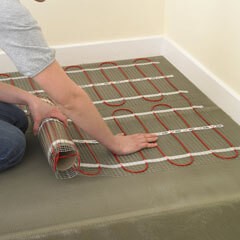Why does the warm floor not heat up and how to solve this problem?
Lack of power
First of all, you need to make sure that the heating system is suitable for power. As a rule, a film or a heating cable is connected through a temperature regulator to which voltage is applied. If the indicators on the temperature controller display are lit, then there is power, if there are no indicators or are not on, you will have to manually check why the underfloor heating does not heat. You need to take a multimeter and check if there is voltage at the input contacts. About, how to use a multimeter, we described in detail in the corresponding article.
By the way, low voltage in the network is also the reason why the warm floor does not heat up to the desired temperature. If 200 volts, rather than 220 volts, comes to the terminals, the heating efficiency is reduced by 20%. To solve this problem you need install a voltage regulator in the house.
The video shows another way to check the regulator:
If there is voltage at the input, you need to make sure that it is normally supplied to the heating cable itself or infrared film. To do this, make sure that no one accidentally touched the settings, as maybe just the temperature is set to a minimum, as a result of which the inclusion of heating does not occur. Also check that the wires to the terminals are securely connected. Bad contact is also the reason why the electric underfloor heating does not heat up or is slightly heated.
Is everything ok with the connection and settings? Measure the voltage at the outlet of the thermostat (terminals to which the heating system itself is connected). In the on state, it should correspond to the network parameters. If this is not the case, the thermostat will have to be replaced.
You can verify the malfunction of the thermostat by connecting the warm floor directly to the network. If the flooring begins to heat up, it means the matter is in the regulator.
System damage
Next, you need to check the temperature sensor and the electric floor heating system itself. To do this, the multimeter measures the resistance of the temperature sensor and the cable itself (or film). If the value does not match the passport, then the device is out of order. A “0” on the tester's display will indicate a short circuit, and a “1” or infinity will indicate an open circuit (may occur as a result of mechanical damage). About, how to repair a warm floor with your own hands, we told in the corresponding article!
You can find out the nominal resistance of the heating element using the formula: R = U2/ P, where U is 220 Volts, and P is the power of the electric floor (you can see it in the passport or using the approximate calculation of 150 W / m2).
We also draw your attention to the fact that the resistance of the temperature sensor decreases when heated, so if the difference compared to the passport data is small, this indicates its serviceability. If the resistance is significantly different from that declared by the manufacturer, then the sensor is defective.
Incorrect installation
In the event that you checked all the elements and they turned out to be serviceable, but the warm floor does not heat up above 22 or, for example, 30 degrees, then the reason is one of three:
- Incorrectly calculated heating power, as a result of which the infrared or cable coating does not warm enough.
- Badly insulated room. Large heat loss prevents heating.
- You improperly performed the installation of heating elements: you made a large step of installation, a thick screed or placed the temperature sensors close to the warm floor.
In this case, you have to redo everything, because the system does not heat up by your mistake and it will turn out to replace at best the location of the sensor, if there really is a reason in it. About, how to make an electric floor for tiles We spoke in detail in the corresponding article. About laying infrared film under the laminate we also talked.
That's all we wanted to talk about why the electric underfloor heating does not heat up and what to do to fix the problem. As you can see, everything is quite simple to determine, the main thing is to be able to use a multimeter!
Related materials:









